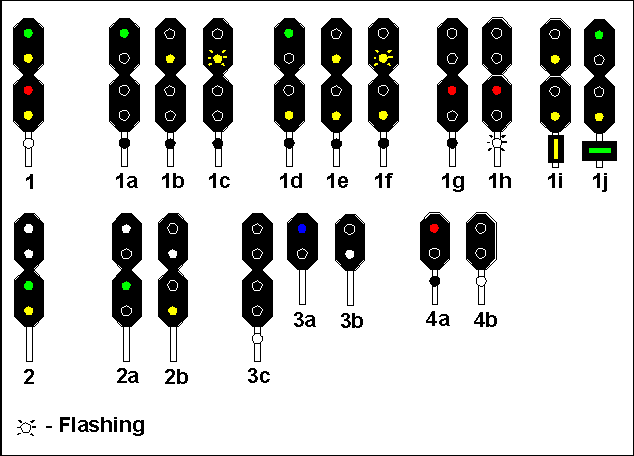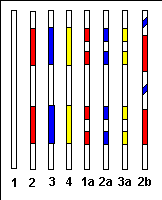
Railroad signals
on the Hungarian State Railvays
by the Gigant Club.

In the 1962-1967 period, MÁV has started to use the speed signalling
system. In this system, the signals are reflect to the speed of the train
in the current, and in the next block.
1. General main signal.
This is the base signal type. Many different subsignals exist,
but all of them can be derived from this.
-
- 1a. Maximum speed allowed in the current and in the next block.
- 1b. Maximum speed allowed in the current block, but you have to stop at the next.
- 1c. Maximum speed allowed in the current, but only 40km/h in the next block.
- 1d. 40km/h allowed in the current and maximum speed in the next block.
- 1e. 40km/h allowed, but you have to stop at the next signal.
- 1f. 40km/b allowed both in the current and in the next block.
- 1g. STOP
- 1h. Calling sign. The train can pass this signal, but only 15km/h allowed,
otherwise the automatic brake will stop the train. It is used, when due to
a failure, or some other reason, the signal cannot be set or
the train have to go to an occupied rail-track.
- 1i. Same as 1f, but only 15km/h allowed instead of 40km/h. The yellow
signal extension is used, when the next block signal is placed inner the
half braking distance.
- 1j. Subtype of 1d, 80km/h allowed in the current block, and maximal
speed in the next.
2. Repeater signals
-
- 2a. The next signal will show free way.
- 2b. The next signal will show STOP.
3. Shunting signals
-
- 3a. No shunting allowed
- 3b. Shunting allowed
- 3c. Shunting allowed, it is used on the 1 type signal.
4. Special signals
-
- 4a. This signal is used at the railway terminals
- 4b. Shunting allowed.
Color of the signposts

- 1. Block signal
- 2. Main signal
- 3. Shunting signal
- 4. Repeater or presignal
- 1a, 2a and 3a. Same as 1,2 and 3, but without a safety equipment.
- 2b. Main signal united with shunting signal. (see above: 3c)


 If you have some questions, problems, suggestions or additions,
please contact the V63 Gigant Club.
If you have some questions, problems, suggestions or additions,
please contact the V63 Gigant Club.
Last update: Mon Apr 14 1997


